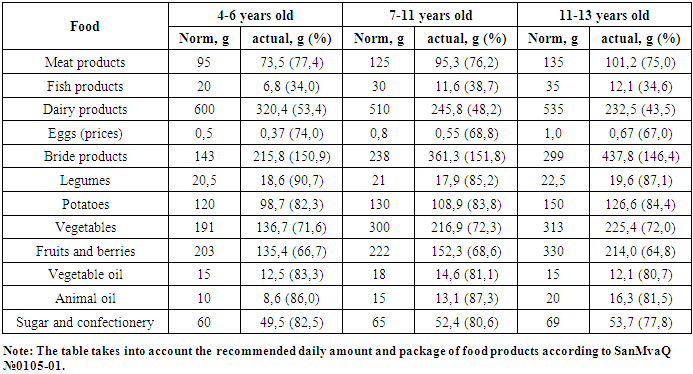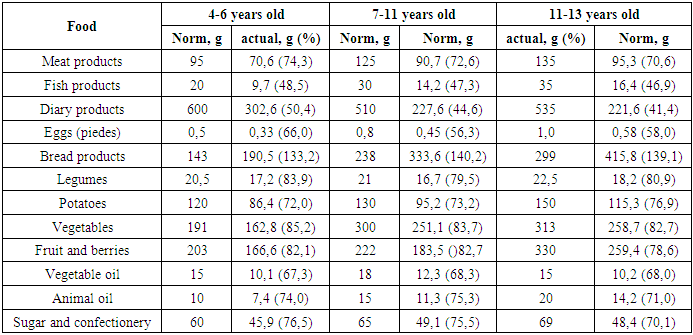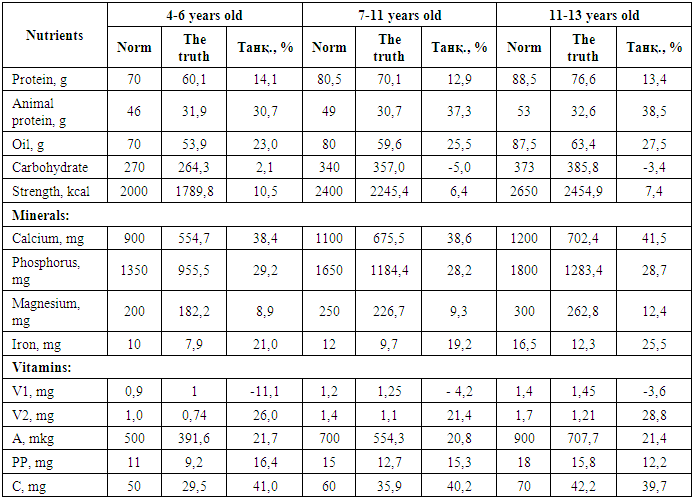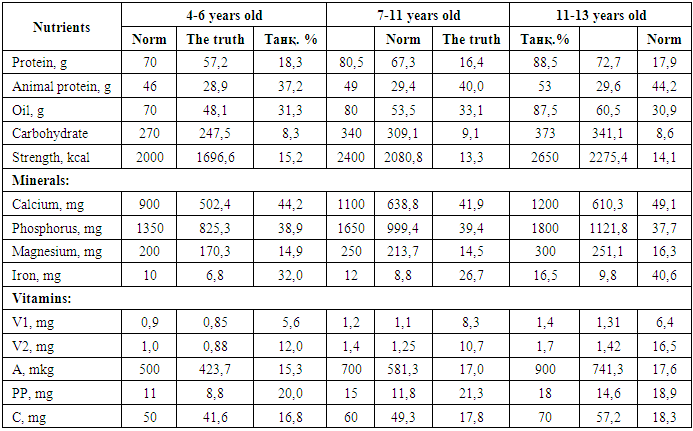-
Paper Information
- Next Paper
- Previous Paper
- Paper Submission
-
Journal Information
- About This Journal
- Editorial Board
- Current Issue
- Archive
- Author Guidelines
- Contact Us
American Journal of Medicine and Medical Sciences
p-ISSN: 2165-901X e-ISSN: 2165-9036
2020; 10(12): 951-955
doi:10.5923/j.ajmms.20201012.05
Received: Nov. 6, 2020; Accepted: Nov. 25, 2020; Published: Nov. 30, 2020

Hygienic Analysis of Nutrition and Food Quality of Children with Oxalat Nephropathy in Preschool and School Age
Shaykhova G. I., Tajieva Z. B.
Department of Children, Adolescents and Food Hygiene, Tashkent Medical Academy, Tashkent, Uzbekistan
Correspondence to: Tajieva Z. B., Department of Children, Adolescents and Food Hygiene, Tashkent Medical Academy, Tashkent, Uzbekistan.
| Email: |  |
Copyright © 2020 The Author(s). Published by Scientific & Academic Publishing.
This work is licensed under the Creative Commons Attribution International License (CC BY).
http://creativecommons.org/licenses/by/4.0/

In recent years, the frequency of kidney diseases in children, including dysmetabolic nephropathy, has increased, which is associated both with improving the quality of diagnosis and the deterioration of the ecological situation. In this regard, the problem of early diagnosis, the appointment of adequate diet and drug therapy is relevant. The article deals with the problem of etiology, pathogenesis, as well as criteria for the diagnosis of dysmetabolic nephropathy in children. Attention is paid to the clinical manifestations of this pathology and the basic principles of treatment and prevention.
Keywords: Children, Dysmetabolic nephropathy, Crystalluria, Oxalaturia
Cite this paper: Shaykhova G. I., Tajieva Z. B., Hygienic Analysis of Nutrition and Food Quality of Children with Oxalat Nephropathy in Preschool and School Age, American Journal of Medicine and Medical Sciences, Vol. 10 No. 12, 2020, pp. 951-955. doi: 10.5923/j.ajmms.20201012.05.
1. Introduction
- One of the most important scientific and practical areas of health care organization and social pediatrics is the regional approach to the study of children's health [1,2,3,4]. Its formation is influenced by climate geographic, ecological and economic living conditions of children, the level of migration, ethnic and socio-cultural characteristics of the population, as well as differences in the material and technical base of treatment and prevention facilities [6,9,10]. Dysmetabolic nephropathy and urinary stone disease are the most prevalent in environmentally unfavorable areas [5,6].The aim of Research. To study the prevalence of oxalate nephropathy and to improve prevention and rehabilitation measures for preschool and school age children in environmentally disadvantaged areas.
2. Research Methods
- Optimal nutrition of preschool and school age children with oxalate nephropathy living in Khorezm region, optimization of treatment and prophylactic measures for dysmetabolic nephropathy, taking into account drinking water.An assessment of the nature of nutrition in our study showed that a common condition can be observed in the diet of children in all cities. Meat and fat deficiency, acute deficiency of dairy products, vegetables and fruits, excess sugar, but according to the literature, high levels of shavel acid and urate metabolism it is well known that it is associated with overconsumption (N.P. Shabalov, 2001). In our study, this fact was partially confirmed. Thus, it must be acknowledged that the anthropotechnogenic factor and the nature of the diet have been identified as primary risk factors for the development of DMN in Khorezm region. To confirm the facts, we present the results of tests for the analysis of food quality of the population of Khorezm region.Based on the results obtained in 2017-2019, it can be said that 2255 trials were conducted for 15 different food products inspected 6349 times. Of these, 30 did not meet the medical and biological response, 107 did not meet the requirements of GOST, and 2803 were detected toxic elements.The interaction of the identified essential and toxic elements reflects the accumulation of toxic elements in the body of a sick child and their participation in tubulointerstitial tissue damage in the absence of essential macro- and micronutrients. However, the positive interaction of toxic elements means that they not only accumulate in the body of children with this pathology, but also synergism, which negatively affects the kidney structures and the immune system.Thus, the entry of toxicogenic micronutrients (exogenous) into the body of a child, their accumulation in organs and systems, a clear imbalance, an increase in silicon and heavy metals in water leads to more rapid development of DMN and their appearance in urine, high levels of oxalaturia, crystalluria, and metabolic disorders in adults. And will be a key factor in the further development of STK, even in children.The analysis of the obtained data showed that meat products (beef, mutton, chicken and their products) from the main foods in the diet of children in the observation group were 22.6-25% lower than the norm in the winter-spring season, respectively, in the summer-autumn season. It was found to be 25.7-29.4% lower. Despite the fact that Khorezm region is located near the Amudarya and there are many reservoirs, we can see that children consume 1/3 of the norm set for the winter-spring season, which is slightly higher than the norm for the summer-autumn season.Dairy products belong to the group of products with high nutritional value: they contain a significant amount of irreplaceable nutrients and have a high ability to be digested and absorbed. In the diet, dairy products are the main source of animal protein (essential amino acids), calcium, phosphorus, vitamins V2 and A, and these substances play an important role in the growth and development of children's bodies. The main group of children observed that they consumed almost half of the recommended norm of dairy products in both seasons (43.5-53.4% in the winter-spring season, 41.4-50.4% in the summer-autumn season).Egg whites are mainly rich in proteins, while the yolk is rich in iron, all reserves of fats, vitamins A, B and D, choline and lecithin. In the analysis of the diet, it was observed that eggs are 26-33% and 34-43.8% lower than the norm, respectively, according to the season.Bread is one of the most consumed products in the diet, has a high nutritional value and provides the body with complex carbohydrates (starch and dietary fiber), proteins, vitamins (V1, V2, V6, RR, folate, E), magnesium, iron. Bread products (bread and flour products) were consumed 33.2-51.8% more than the norm in both groups (winter-spring and summer-autumn) in all three seasons.Legumes and legumes are the main source of complex carbohydrates (starch) in the human diet, providing 70-90% of this macronutrient in the diet. Their protein is deficient in lysine and threonine, and their biological value is not high. At the same time, the mixture satisfies about 40% of the need for protein in a balanced diet. It was found that children consumed these products significantly less than the norm (9.3-20.5%).Vegetables and fruits are a unique source of essential nutrients: ascorbic acid, b-carotene, bioflavonoids. They contain significant amounts of dietary fiber, magnesium, potassium, iron, folic acid, vitamin K. Of the carbohydrates, the natural forms of mono- and disaccharides are relatively more widespread, and a number of vegetables (potatoes) contain significant amounts of starch. It was found that children consumed slightly more potatoes (11.3-13.7 g) in the winter-spring season than in the summer-autumn season. In the analysis of consumption of vegetables and fruits, we can see the opposite, that is, in the summer-autumn season compared to the winter-spring season consumed 26.1-33.3 g of vegetables and 31.2-45.4 g of fruits. This situation can be explained by the abundance and low cost of these products in the summer-autumn season.Children consumed mainly cottonseed and sunflower oils from vegetable oils, which was 16.7-32.7% less than the norm, regardless of the product season. The most butter was consumed from animal fats, which was 81.5-87.3% in the winter-spring season and 71-74% in the summer-autumn season.Sugar and confectionery products were found to be below the norm in the diet in both seasons: 77.8-82.5% and 70.1-76.5%, respectively. It should be noted that these products were consumed more in young children than in adults.
|
|
|
|
3. Conclusions
- In general, the structure of hospitalization pathology of the main group of children under investigation and diseases of the urinary system of children showed that it depends on the area where children live, its ecological and biogeochemical characteristics. Poor quality and unsuitability of water and food rations in the region, non-compliance with the requirements often lead to the development of dysmetabolic nephropathy (oxalaturia, crystalluria), as well as secondary immunodeficiency in children increases the urinary tract microbial-inflammatory processes, dysmetabolic diseases urinary stones leads to the development of diseases.
 Abstract
Abstract Reference
Reference Full-Text PDF
Full-Text PDF Full-text HTML
Full-text HTML


